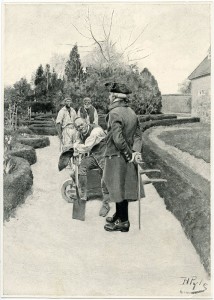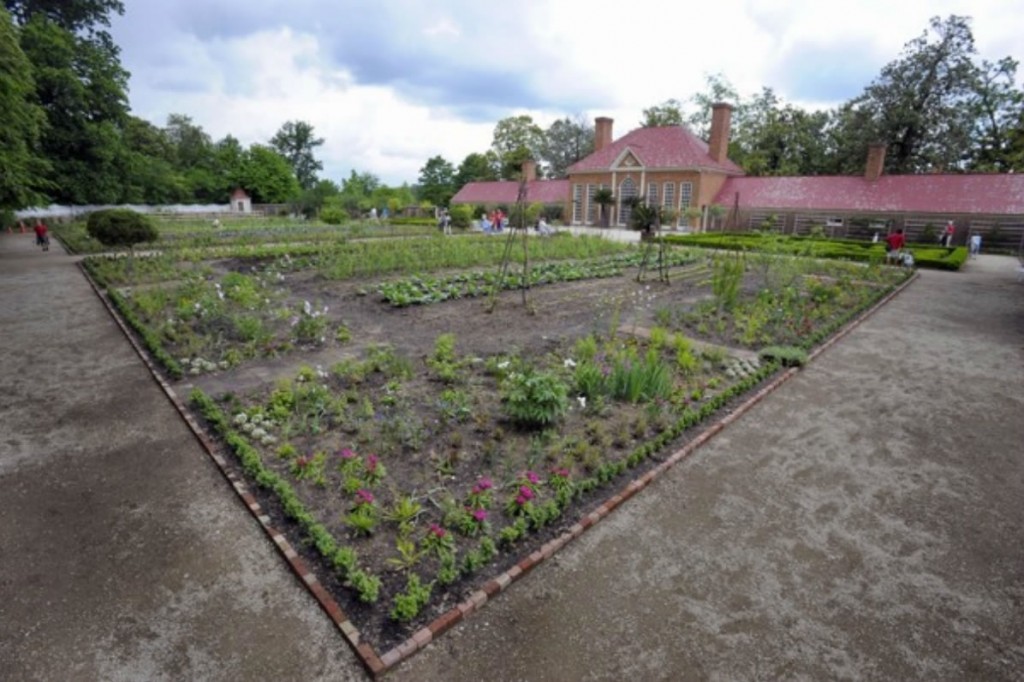 George Washington’s Upper Garden on his Mount Vernon estate has for many years been the province of English boxwood and formal rose gardens, but has now been returned to its original practical beauty. The experts had assumed that the boxwood, those scions of the classic English garden, were original to Washington’s time, and even the roses were if not fully original, at least close to it. In the 1980s, new research showed that the hybrid tea roses didn’t even exist until 1860; later tree-ring counts performed on deceased boxwoods proved they had been planted around the same time as the roses.
George Washington’s Upper Garden on his Mount Vernon estate has for many years been the province of English boxwood and formal rose gardens, but has now been returned to its original practical beauty. The experts had assumed that the boxwood, those scions of the classic English garden, were original to Washington’s time, and even the roses were if not fully original, at least close to it. In the 1980s, new research showed that the hybrid tea roses didn’t even exist until 1860; later tree-ring counts performed on deceased boxwoods proved they had been planted around the same time as the roses.
In 1985, the garden was redesigned to bring it closer into line with the authentic garden Washington enjoyed. The roses were removed and replaced with smaller plots of ornamental flowers. The boxwoods, however, remained, kept in place by their own mythology and the mythology they supported of Washington as American royalty. The boxwoods couldn’t live forever, though, and as they began to perish and get removed six years ago, Esther White, Mount Vernon’s director of archaeology, finally had the opportunity to excavate the garden. She discovered evidence of Washington’s first plantings: fruit trees in the 1760s.
Excavations continued over the next few years, the team finding multiple versions of the garden from different periods until they were able to pinpoint the layout of the 1780s garden. It was walled and bullet-shaped walled, with wide paths and fewer large, long beds instead of the small crescent beds that had characterized the garden for so many years.
Starting in August of last year, Dean Norton, Mount Vernon’s director of horticulture, and his team began a complete redesign of the Upper Garden to return it to as close to its 1780s landscaping as possible. No more mannered hedges and small groupings of pretty flowers. They used the layout they had discovered, originally designed by Samuel Vaughan, and turned to Washington’s own weekly gardener’s reports to see what he had planted. It wasn’t roses; it was crops.
Which raises the question: Why weren’t these detailed reports used earlier to fashion the Upper Garden? The answer, of course, is that while the new garden speaks to Washington the man, the previous, embroidered versions told of Washington the myth. (The Upper Garden’s twin, the Lower Garden, remains an idealized Colonial Revival fruit and vegetable garden.)
“The [Upper] Garden became a reflection of everything we in the 19th and 20th century think about Washington, this romanticized view of the 18th-century man, strolling his pleasure garden, taking in the colors, the fragrances,” White said. “It’s our projection. One of the things the project did was to make people wipe clean their idea of what the garden should be. We all started again.”
 There’s an excellent example of that mythologizing at work in this fascinating blog entry about artist Howard Pyle. In 1896 he wrote a letter to future President Woodrow Wilson in which he describes a painting he wanted to make of Washington the gentleman farmer, the Cincinnatus figure who served his nation when called upon, only to return to his noble bucolic life as man of the earth as soon as possible. “I am informed that the box-walk at Mount Vernon is now very much as it was in Washington’s day. It is very picturesque, and it would be interesting to place Washington in it as a setting,” says Pyle.
There’s an excellent example of that mythologizing at work in this fascinating blog entry about artist Howard Pyle. In 1896 he wrote a letter to future President Woodrow Wilson in which he describes a painting he wanted to make of Washington the gentleman farmer, the Cincinnatus figure who served his nation when called upon, only to return to his noble bucolic life as man of the earth as soon as possible. “I am informed that the box-walk at Mount Vernon is now very much as it was in Washington’s day. It is very picturesque, and it would be interesting to place Washington in it as a setting,” says Pyle.
The thing is the rows of vegetables rimmed with flowers and clusters of fruit trees would have been, if less picturesque, certainly impressive showings of wealth in Washington’s time. Just because it was practical doesn’t mean it wasn’t also indicative of the landowner’s wealth, available leisure time and large, in this case enslaved, labor force.
The restoration is now almost complete, and it sounds dreamy.
In rebuilding the garden — the construction took place between August and November — crews brought in 350 cubic yards of soil and compost. Bulbs were planted in late 2010, the remaining plantings this spring. Eight mature apple, pear and cherry trees were moved to the orchard bed.
In late spring, the beds of decorative plants feature a mixture of all sorts of heirloom plants — bulbs, annuals, perennials, biennials, shrubs and roses. The gardeners have planted vegetables in strict rows, including peas, beans, beets, lettuce, potatoes, spinach and lots of cabbage-family plants.
